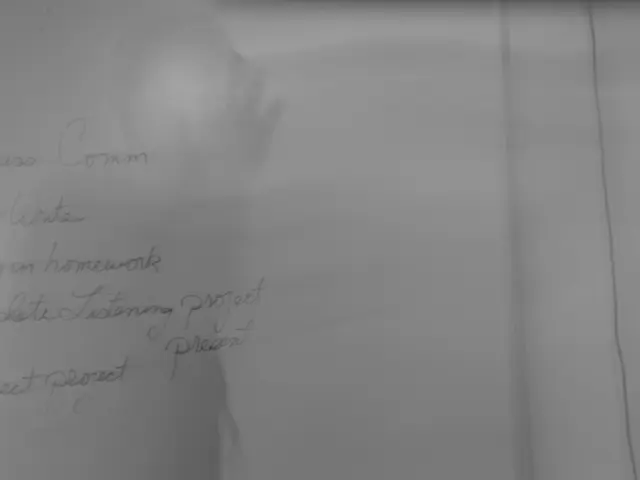Utilizing Deep Breathing Techniques to Reestablish Inner Tranquility
Deep breathing, often referred to as belly or diaphragmatic breathing, is a quick and practical solution for alleviating stress and anxiety. It focuses on activating your parasympathetic nervous system, promoting relaxation and a sense of tranquility. To help you kickstart your journey towards inner calm, here are some popular, scientifically-backed techniques to explore:
Keys to Deep Breathing for Stress Relief
1. Diaphragmatic Breathing
This technique emphasizes breathing deeply into your diaphragm. As you inhale, your abdomen should rise, while exhaling causes it to fall. Placing a hand on your abdomen offers tactile feedback to guide your breathing [2].
2. 4-7-8 Breathing
Developed by Dr. Andrew Weil, this method includes inhaling through your nose for 4 seconds, holding the breath for 7 seconds, and then exhaling slowly through your mouth for 8 seconds. It's a powerful stress reducer and can enhance sleep quality [4].
3. Extended Exhale Breathing
Breathe in through your nose for 4 seconds, followed by an extended, controlled exhale through your mouth for 6-8 seconds. This technique triggers the 'rest and digest' response, helping to diminish anxiety and stress [1].
4. Box Breathing
Also known as Square Breathing, this method involves inhaling, holding your breath, exhaling, and then replicating these steps for equal counts (e.g., 4 seconds for each step). It's a structured technique often employed by the military for relaxation and focus [2].
5. Power Breathing
This technique invigorates you with 20-30 quick, forceful inhales and exhales in one second, followed by a slow, deep inhale and exhale to reset your body and mind. It's useful when you need a mental boost, like in the morning or during an afternoon slump [1].
6. Sitkari Pranayama (Yoga Technique)
Inhale through a slightly scrunched mouth while keeping your tongue near the teeth, then exhale through the nose. This cooling practice is beneficial for reducing anxiety and insomnia [5].
7. Long Exhale Breathing (1:2 Ratio)
By extending your exhale to twice the length of your inhale (e.g., inhale for 4 seconds, exhale for 8 seconds), you relax your nervous system and experience reduced anxiety and stress. It's particularly helpful before sleep or as relief during stressful moments [5].
8. Counting Breaths
Simply focus on counting each breath to improve concentration and reduce stress. It engages the analytical mind in a calming practice [2].
Deep Breathing Benefits
- Triggers the parasympathetic nervous system ("rest and digest")
- Lowers heart rate and calms the mind
- Reduces anxiety, stress, and feelings of overwhelm
- Improves cognitive clarity and focus
- Supports better sleep quality
- Accessible and adaptable for people with different physical abilities
Deep Breathing Tips
- Practice daily or any time stress arises.
- Start with shorter sessions and gradually increase duration comfortably.
- Combine with mindfulness or meditative practices to reap maximum benefits.
- Consult a healthcare provider if you have respiratory issues or trauma related to breath control before starting.
These techniques are grounded in psychological and neuroscientific research and are commonly used in therapeutic settings such as trauma-informed care, cognitive behavioral therapy, and mindfulness-based stress reduction [1][2][5]. So why wait? Dive deep into these stress-relieving practices today and embrace the strides towards inner calm.
[1] https://www.healthline.com/health/breathing-exercises-for-stress[2] https://www.psychologytoday.com/us/blog/feeling-it/201910/how-deep-breathing-helps-stress-and-anxiety[4] https://www.healthline.com/health/4-7-8-breathing[5] https://breathwrk.com/7-proven-breathing-techniques-to-calm-anxiety-and-recharge-your-nervous-system/
- Deep breathing techniques, such as diaphragmatic breathing, 4-7-8 breathing, extended exhale breathing, box breathing, power breathing, Sitkari Pranayama, long exhale breathing, and counting breaths, can help reduce stress and anxiety, promote relaxation, and improve mental health.
- These techniques are backed by scientific research and are often used in therapeutic settings, including trauma-informed care, cognitive behavioral therapy, and mindfulness-based stress reduction.
- Deep breathing can activate the parasympathetic nervous system, lower heart rate, calm the mind, reduce anxiety and feelings of overwhelm, and improve cognitive clarity and focus.
- Regular practice of deep breathing techniques and combining them with mindfulness or meditative practices can provide maximum benefits for health, wellness, and productivity.
- For optimal results, practice deep breathing daily or whenever stress arises, start with shorter sessions and gradually increase the duration comfortably, and consult a healthcare provider if you have respiratory issues or trauma related to breath control before starting.
6.Deep breathing can also support better sleep quality, making it a valuable addition to a healthy lifestyle focused on mental health and overall well-being.




